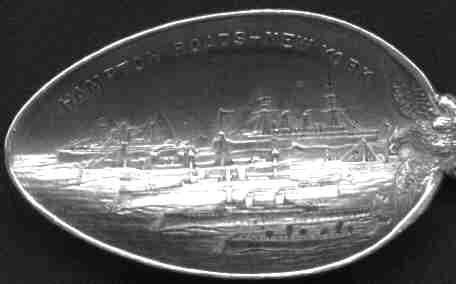
Exhibit 1
The 1893 Columbus World Fair in Chicago was one of the major impetuses for the collecting of silver souvenir spoons. The fair opened about two years after the infamous Witch spoon became such a fantastic seller. Dozens of manufacturers tried to re-create the success of this first "souvenir spoon" and in the process they created over 300 varieties of souvenir spoons for this world fair (more than for any other single event in history).

The Chicago Columbian World Fair was arguably the most successful exposition of its kind and it proudly proclaimed an unlimited future. The architecture was in the Beaux-arts style which would become the dominant architectural style for the next 30 years. It also ushered in the era of "arts and crafts" in the USA and was a prelude to the "art deco" movement.
By 1893, after years of planning, the fantastic "great white city" celebrating the 400th anniversary of the "discovery of the new world" opened amid economic devastation in an economy that was described as a "monetary panic". The economy was in disarray and economic output was down over 25%. (click for more)
The exposition presented thousands of exhibits in 17 huge buildings that enclosed over 100 acres of space (an acre is over 43,000 sq ft). The exhibits presented the latest information in the fields of arts, mechanics, agriculture, liberal arts, fishing, electricity, horticulture, manufacturing, mines and mining, transportation, woman's accomplishments etc. Cultures from all over the world were represented and the fair was the equivalent of a current encyclopedia of all known knowledge.
Many states and foreign countries also constructed smaller buildings at the fair.
One of the most notable exhibits was a new thrill ride--the "Ferris Wheel".
 plated
version of the Ferris wheel
plated
version of the Ferris wheel
An area of amusement rides and adult entertainment was located in the center and became known as the "Midway", a term which is still used.
The landscaping and the grounds were judged to be "fantastic" and the use of water was far superior to anything which had ever before been done in this regard.
Obviously an exposition of this magnitude cannot be summed up in a few paragraphs. Entire volumes have been written and this project has influenced all world fairs to date.
Chris McGlothlin has done a magnificent job in cataloging the many varieties of spoons which were created for this fair in his book "World's Fair Spoons, vol 1. The World's Columbian Exposition". He shows well over 300 varieties of spoons which range in price from $5 to $2500. A few copies of this book are still available and should be in every spoon collector's library. If you do not own this book, please contact me and I will refer you to the author. Some of the information on the following spoons have been obtained from this book.
A few of these spoons are shown here for your enjoyment.

One of the major "pre-events" was a fantastic naval armada of U.S. and Foreign warships which accompanied full scale replica's of the three ships (Nina, Pinta, Santa Maria) commanded by Columbus. The Armada left Hampton Roads, Virginia and proceeded to New York (where this spoon is from) and then on to Chicago. (note the eagle on the right of bowl)
This exhibit has now grown to the point where it is too big for a single web page. Therefore to make downloading "less painful", I have broken the exhibit into several web pages. You can just click "Visit next Columbian exhibit" to see many of the wonderful spoons that are still available to the collector.
or visit the pages on your own
| Columbian Exhibit 2 | 3/29/99 |
| Columbian Exhibit 3 | 3/29/99 |
| Columbian Exhibit 4 | 4/12/01 |
| Columbian Exhibit 5 | 3/29/99 |
| Columbian Exhibit 6 | 3/29/99 |
| Columbian Exhibit 7 | 8/17/98 |
A very unusual Peter Hertz spoon featuring a viking ship is shown in the Nordic Enamels chapter. I suspect that this is related to the Leif Erickson/ Columbian fair, because it has many similar design elements as a piece pictured on pp58-59 of "World's Fair Spoons". However, the author of that book, believes that the piece cannot be properly attributed to the Columbian fair without further documentation.